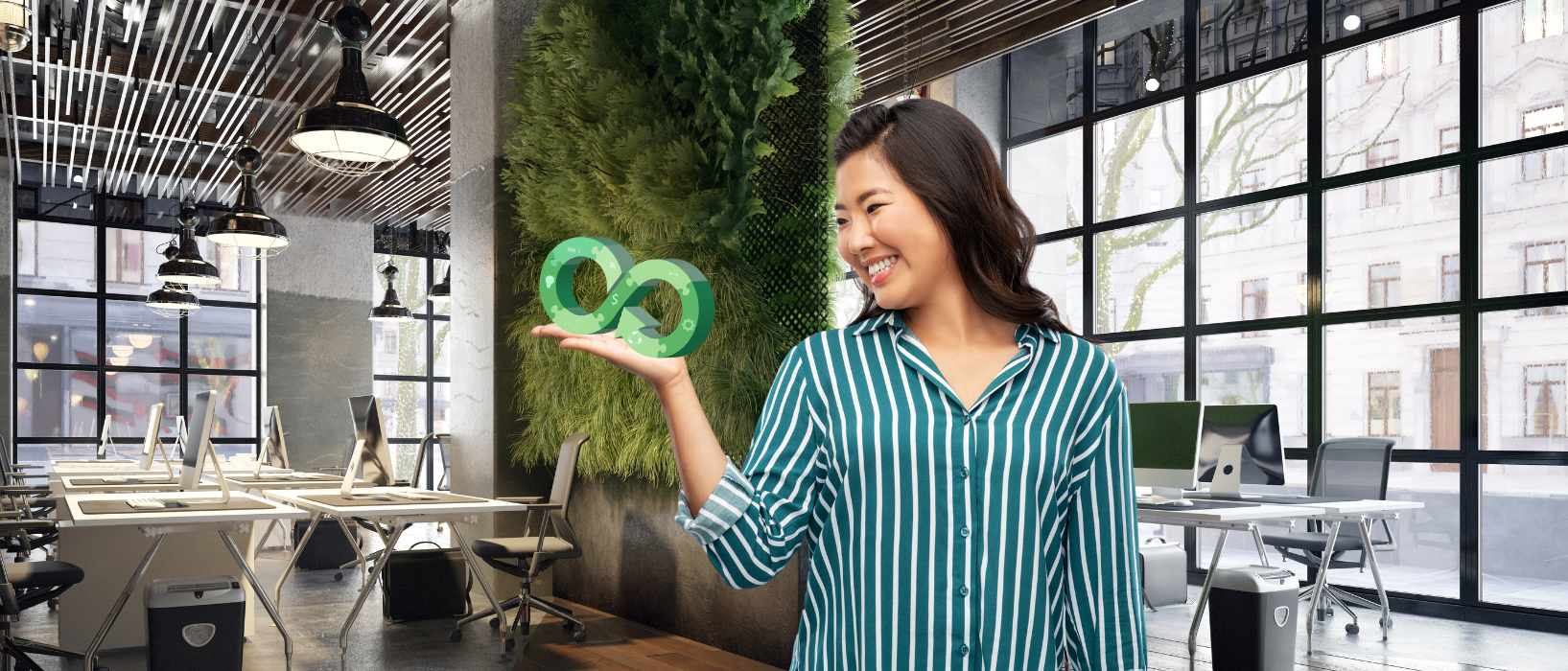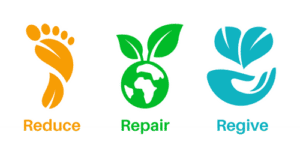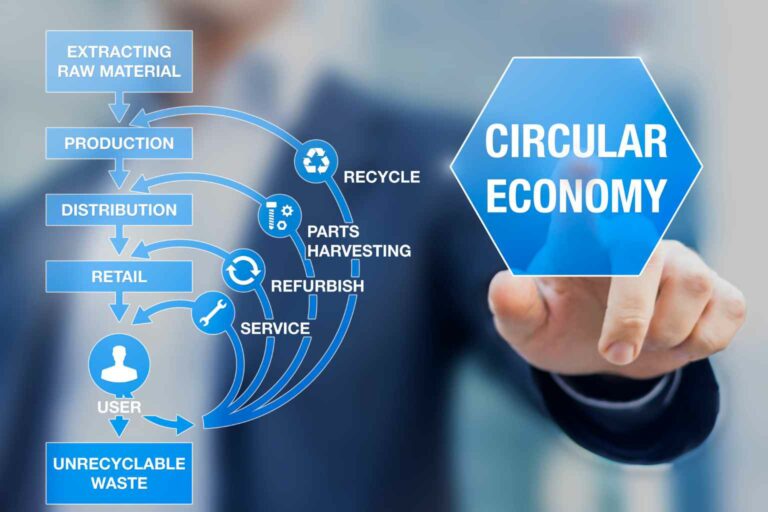
The Circular Economy: Introduction
Welcome to Play it Green’s guide to the circular economy! In this article, we explore the transformative concept of this method, where resources are used efficiently, waste is minimised, and sustainability takes centre stage.
The circular economy is a regenerative system that breaks free from the traditional linear model. Instead of discarding materials, it promotes their reuse, recycling, and repurposing, creating a closed-loop system that maximises value and minimises environmental impact.
Join us as we uncover the benefits and opportunities this way of doing things presents. From reducing pollution to driving innovation, this new method offers a blueprint for a greener, sustainable future.

The Circular Economy: What Is It?
The concept of a circular economy, dating back to the 1970s, draws from regenerative models such as cradle-to-cradle, biomimicry, and industrial symbiosis. In the present tense, the circular economy aims to replace the linear “take, make, dispose” approach to production and consumption.
It was not until the 1980s however when it was popularised by the renowned economist David Pearce. Pearce recognised the need to shift away from the traditional linear model and proposed a regenerative system that focuses on sustainable resource use and waste reduction. His influential work laid the foundation for further development and adoption of the circular economy principles.
Contrary to common misconceptions, the circular economy extends beyond recycling. While recycling is an important aspect, it represents just one of the outermost loops within the circular economy, capturing the least value. In fact, recycling often reduces the quality and usability of the recycled material.
The process encompasses various other loops, including refurbishment, remanufacture, and asset utilisation. Implementing these processes requires a fundamental rethinking of how goods and services are designed, produced, and accessed.

The core objective of the circular economy is to design out waste from the entire system while minimising the negative impacts of industrial processes. Processes such as material leakage, energy consumption, and emissions. To effectively transition to a circular model, it is crucial to embrace renewable energy sources. Which in turn supports the restoration of economic and natural capital.
The Circular Economy: Why Is It Important
What makes the circular economy so important to our economy? The answer lies in the urgent need to improve resource resilience. Our current trajectory is unsustainable due to non-renewable resources and unsustainable consumption behaviours. According to researchers, humanity extracts a whopping 100 billion tonnes of brand-new raw materials each year.
Businesses must emphasise design innovations, resource productivity, and ecological restoration to fulfil the future consumption requirements of our rising population and developing nations in the Global South. To achieve net-zero emissions, we will need to make radical modifications to our material systems.
This innovative method offers a viable and cost-effective alternative. It entails reusing and relocating existing items and waste resources to suit new demands. We may rethink consumer interactions with goods and services by providing new services that optimise unused resources.
Consider selling things as services or subscriptions, with aftercare and free return options. This strategy not only increases affordability but also promotes long-term usage. Several studies have highlighted the potential advantages of moving to a circular economy.

According to a major study conducted by McKinsey and the Ellen MacArthur Foundation, following circular practices in Europe could enhance resource productivity by 3% by 2030. This could result in €600 billion of yearly savings in costs and extra-economic gains totalling €1.8 trillion. Continue reading to learn more about this innovative method’s transformative potential and how it might help build a sustainable future.
The Circular Economy: In Practice
While no city, region, or country has fully embraced the circular economy, businesses in a variety of industries are incorporating circular strategies into their business models and value chains. The automotive and textile sectors, for example, are setting the standard. Closed-loop procedures are used by companies such as Renault, Toyota, and Jaguar Land Rover to manufacture remanufactured automobile parts.
H&M, Nike, and Timberland are using post-consumer waste in their goods and researching breakthrough methods for stronger fibres. Circular techniques can be applied to entire geographical regions as well as individual firms. Cities, as central resource hubs, allow the local recirculation of valuable resources and foster cross-sector collaboration.
Leading cities including Amsterdam, London, Copenhagen, and Glasgow have created plans to incorporate circular thinking into their urban settings. Globally scaling up with this method remains a huge problem. According to the 2023 “Circularity Gap” report from Circle Economy, just 7.2% of the globe functions in a circular fashion, with over 90% of global raw materials not recycled.

Every year, the global economy consumes an astounding 100 billion tonnes of commodities. Despite the difficulties, progress is being made. The UK already operates one-fifth of its economy in a circular method, with an estimated value of £40 billion. To create a 50% circular economy by 2030, the Netherlands has embraced the revolutionary “doughnut economics” approach in Amsterdam.
The Circular Economy: The Benefits
The circular economy offers numerous benefits that businesses should consider. Firstly, it serves as a driver for value protection by maximizing the use of materials and resources, resulting in cost savings and more durable products. Cost benefits are also significant with this innovative method.
UK businesses alone could save up to £23bn annually through efficient resource use. Reselling, component recovery, and creating durable products reduce raw material costs and warranty risks. Environmental benefits are equally crucial.
Around 90% of raw materials used in manufacturing become waste, contributing to the nature and climate crises. Adopting a circular economy approach can reduce emissions associated with material use and encourage the use of less toxic materials. Operational resilience is enhanced by mitigating price volatility and supply risks.
Shifting towards energy-efficient materials and primary resource extraction creates new revenue opportunities and diversifies markets. Collaboration and engagement are vital for a circular transition. Companies should foster staff education, stakeholder engagement, and strategic supplier partnerships.

Sharing knowledge and expertise can drive innovation and best practices. Social benefits include satisfying consumer demand for longer-lasting products, saving customers money, and generating employment opportunities in the maintenance, collection, and repurposing of goods. Circular initiatives also alleviate poverty in low-income countries.
That’s a Wrap
The circular economy offers businesses a sustainable and resource-efficient model with numerous benefits. It enables companies to retain value, reduce costs, and mitigate environmental impacts. By embracing circular strategies, businesses can diversify markets, foster innovation through collaboration, and create employment opportunities.
Not only that but using this method satisfies consumer demand for longer-lasting products and contributes to poverty alleviation. It is a transformative approach that drives competitiveness and long-term success while safeguarding the environment. Embracing this new method is key to creating a thriving and sustainable future for all.
If you’re passionate about sustainability, transparency and positive impact. If you want to take your efforts to the next level. Then we encourage you to join the Play It Green community.
For just £5 per month, you’ll have access to a supportive network of like-minded individuals and resources to help you make even more sustainable choices in your daily and working life.
As well as that you will plant lots of trees and regift to a charity of your choice.
Together, we can create a brighter and more sustainable future for all.





